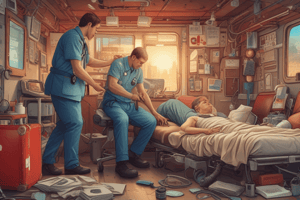Podcast
Questions and Answers
What is one of the initial indicators of shock?
What is one of the initial indicators of shock?
- Cyanosis
- Weak pulse
- Rapid breathing
- Pale and cold skin (correct)
What should you do first in case of shock?
What should you do first in case of shock?
- Raise the casualty’s legs above heart level. (correct)
- Call for emergency services.
- Monitor vital signs.
- Loosen the casualty's clothing.
Which of the following actions can help prevent dehydration during vomiting and diarrhea?
Which of the following actions can help prevent dehydration during vomiting and diarrhea?
- Administer sugary drinks.
- Provide solid food immediately.
- Restrict fluid intake.
- Give frequent sips of water. (correct)
What is a possible cause of neurogenic shock?
What is a possible cause of neurogenic shock?
During which stage of shock is the heart likely to stop?
During which stage of shock is the heart likely to stop?
What color indicates cyanosis in a casualty?
What color indicates cyanosis in a casualty?
Diarrhea and vomiting are primarily caused by what?
Diarrhea and vomiting are primarily caused by what?
What is a common preventive measure against infectious diarrhea?
What is a common preventive measure against infectious diarrhea?
What is the most common cause of seizures?
What is the most common cause of seizures?
What is a typical sign of a seizure during its onset?
What is a typical sign of a seizure during its onset?
Which of the following describes the appropriate action after convulsive movements have stopped in a seizure?
Which of the following describes the appropriate action after convulsive movements have stopped in a seizure?
What physical changes may occur during a seizure?
What physical changes may occur during a seizure?
What should be done to protect a person experiencing a seizure?
What should be done to protect a person experiencing a seizure?
What can be observed if a person has bitten their lip or tongue during a seizure?
What can be observed if a person has bitten their lip or tongue during a seizure?
What should not be done immediately after a seizure?
What should not be done immediately after a seizure?
What is the condition called when the linings surrounding the brain and spinal cord become inflamed?
What is the condition called when the linings surrounding the brain and spinal cord become inflamed?
Which symptom is specifically associated with the development of meningitis?
Which symptom is specifically associated with the development of meningitis?
What is a possible outcome of untreated meningitis?
What is a possible outcome of untreated meningitis?
What action should be taken if meningitis symptoms are suspected?
What action should be taken if meningitis symptoms are suspected?
Which of the following is NOT a common cause of shock?
Which of the following is NOT a common cause of shock?
How much blood loss can lead to shock?
How much blood loss can lead to shock?
Which symptom indicates that the casualty may be developing meningitis?
Which symptom indicates that the casualty may be developing meningitis?
What is one of the main roles of the circulatory system that may be impaired in shock?
What is one of the main roles of the circulatory system that may be impaired in shock?
What should be done while waiting for medical help in case of suspected meningitis?
What should be done while waiting for medical help in case of suspected meningitis?
Flashcards
Seizure Definition
Seizure Definition
Involuntary muscle contractions caused by a disturbance in brain electrical activity.
Seizure Causes
Seizure Causes
Often epilepsy, head injury, brain diseases, oxygen/glucose shortage, or poison (alcohol/drugs).
Seizure Recognition - Stage 1
Seizure Recognition - Stage 1
Sudden loss of responsiveness, rigid body, noisy/difficult breathing.
Seizure Recognition - Stage 2
Seizure Recognition - Stage 2
Signup and view all the flashcards
Seizure Recognition - Stage 3
Seizure Recognition - Stage 3
Signup and view all the flashcards
Meningitis Definition
Meningitis Definition
Signup and view all the flashcards
First aid for Seizures - Step 1
First aid for Seizures - Step 1
Signup and view all the flashcards
First aid for Seizures - Step 2-3-4
First aid for Seizures - Step 2-3-4
Signup and view all the flashcards
Meningitis Symptoms
Meningitis Symptoms
Signup and view all the flashcards
Meningitis Treatment
Meningitis Treatment
Signup and view all the flashcards
Meningitis Cause
Meningitis Cause
Signup and view all the flashcards
Shock Definition
Shock Definition
Signup and view all the flashcards
Shock Cause (Blood Loss)
Shock Cause (Blood Loss)
Signup and view all the flashcards
Shock Causes (Other)
Shock Causes (Other)
Signup and view all the flashcards
Shock Management
Shock Management
Signup and view all the flashcards
Shock Recognition
Shock Recognition
Signup and view all the flashcards
What is shock?
What is shock?
Signup and view all the flashcards
What are the initial signs of shock?
What are the initial signs of shock?
Signup and view all the flashcards
What happens as shock progresses?
What happens as shock progresses?
Signup and view all the flashcards
What are additional symptoms of progressing shock?
What are additional symptoms of progressing shock?
Signup and view all the flashcards
What's the first aid for shock?
What's the first aid for shock?
Signup and view all the flashcards
What other actions can you take for shock?
What other actions can you take for shock?
Signup and view all the flashcards
Vomiting & Diarrhea: What causes them?
Vomiting & Diarrhea: What causes them?
Signup and view all the flashcards
How to help with vomiting and diarrhea?
How to help with vomiting and diarrhea?
Signup and view all the flashcards
Study Notes
Lecture 5: First Aid of Medical Emergencies
-
Seizures (Convulsions): Involuntary muscle contractions due to brain electrical activity disturbance. Common causes include epilepsy, head injury, brain diseases, low oxygen/glucose, and poison intake (alcohol, drugs).
-
Seizure Recognition: Often follows a pattern, including sudden loss of responsiveness, back rigidity and arching, noisy/difficult breathing (grey-blue tinge), convulsive movements, saliva (potentially blood-stained), possible loss of bladder/bowel control, then muscle relaxation and normal breathing. The casualty may be dazed and fall into a deep sleep after.
-
Seizure First Aid: Create space, remove hazards, protect the head, monitor the time the seizure started, place soft padding, open airway and check breathing once the seizure stops. Place in recovery position if breathing. Monitor and record vital signs (breathing, pulse, level of response) and the seizure duration.
-
Meningitis: Condition where the brain and spinal cord linings become inflamed. Caused by bacteria or virus, affecting all age groups. May cause quick deterioration. Urgent medical assistance is vital.
-
Meningitis Symptoms (Recognition): Flu-like illness (high fever), cold hands/feet, joint/limb pain, mottled skin. As infection develops symptoms can include severe headache, neck stiffness (cannot touch chin to chest), vomiting, sensitive eyes (to light), drowsiness, and a distinctive rash of red or purple spots that don't fade.
-
Meningitis First Aid: Seek urgent medical advice immediately, treat fever, check for rash, reassure and keep casualty cool, monitor vitals (breathing, pulse, level of response).
-
Shock: Life-threatening condition caused by circulatory system failure, depriving vital organs (heart, brain) of oxygen. Can be worsened by fear and pain. Common causes are severe blood loss (>1.2 liters), vomiting, diarrhea, serious burns, heart conditions, infection, allergic reactions or spinal cord injuries.
-
Shock Recognition (Initially): Rapid pulse, pale and cold skin, sweating. As shock develops: rapid breathing, weak pulse, grey-blue skin (cyanosis), weakness, dizziness, thirst, nausea, possibly vomiting. If brain's oxygen supply weakens, the casualty becomes unresponsive. Eventually heart will stop.
-
Shock First Aid: Treat the cause, encourage casualty to lie down on a blanket (protect from cold), raise and support legs above the heart level to improve blood supply to the vital organs, loosen tight clothing, keep warm, monitor and record vitals.
-
Vomiting and Diarrhea: Usually due to digestive system irritation from viruses, bacteria, parasites, contaminated food/water or other irritants. Can lead to dehydration, especially in infants, children, and elderly.
-
Vomiting and Diarrhea Recognition: Nausea, vomiting, later diarrhea, stomach pains, fever.
-
Vomiting and Diarrhea First Aid: Reassure casualty, wipe face, give sips of water/unsweetened fruit juice slowly when vomiting stops, give easily digestible foods (pasta, bread, potatoes) after eating stops.
Studying That Suits You
Use AI to generate personalized quizzes and flashcards to suit your learning preferences.
Related Documents
Description
This quiz covers essential first aid procedures for medical emergencies, focusing on seizures and meningitis. It discusses recognition signs, immediate care steps, and how to assist effectively during such situations. Gain knowledge to respond confidently in emergencies and potentially save lives.





